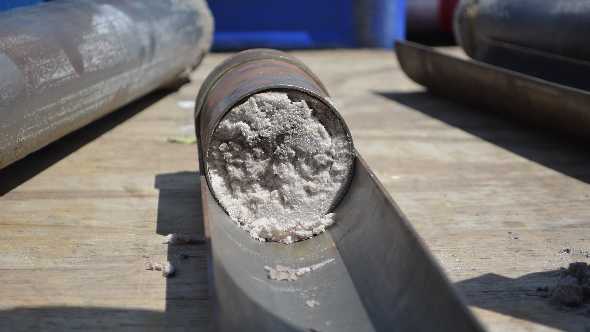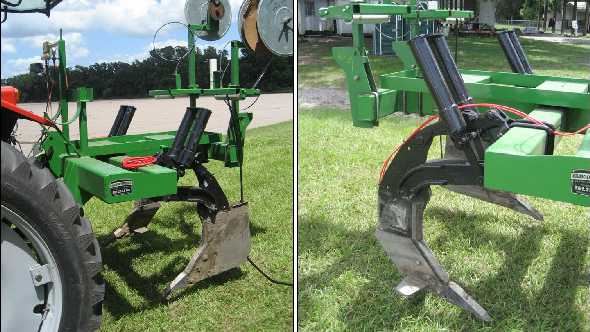Approach To Nematode Control Changing In Post Methyl Bromide Era

Longtime UF/IFAS researcher Joe Noling knows nematodes.
Photo by Frank Giles
For something so tiny, nematodes can do a nasty number on crops. When it comes to nematode knowledge, Joe Noling is the go-to guy for Florida specialty crop producers. The UF/IFAS professor and nematologist has been on the cutting edge of nematode management recommendations as practices have been evolving with the phase-out of methyl bromide.
“If you talk to many growers, I don’t think you will find too many who have not observed an increase in individual and/or combinations of pest problems in at least some of their fields,” Noling says. “Back in 2011, growers were asked to indicate average production losses due to pests associated with the methyl bromide phase-out and the average was 8%. It is undoubtedly higher at this time.”
Plant parasitic nematodes, most notably sting and root knot nematode, have a very wide host range and thrive in warm, moist, and sandy soils.
“There are not too many fields in Florida that don’t match those preferences, thus there is potential for serious problems to develop,” Noling says.
The list of challenges from various parts of the state is lengthy. In includes phytotoxicity to subsequent crops following fumigation, a Telone II (1,3-dichloropropene, Dow AgroSciences) prohibition in Broward and Dade counties, new fumigant labels and buffer zones, and a supply problem with Vydate (oxamyl, DuPont), an important post-crop rescue nematicide treatment. Noling says the list goes on making nematodes a formidable pest.
Digging Deeper
Given the challenges surrounding nematode infestations, growers have to do just about everything right. And even then, crop losses can be significant. Since the methyl bromide phase-out, Noling has been working with growers on enhanced scouting and management techniques.
Historically, nematode densities in the field have been determined by soil sampling and lab assays. However, due to their patchy distribution in tilled or fallowed soil prior planting, there is no assurance of obtaining an accurate assessment. This especially true when shallow soil samples are taken at 8 to 10 inches.
“The problem is further amplified as we have recently rediscovered that root knot and sting nematodes can occur at depths of 3 to 4 feet in the soil,” Noling says. “That is well below depths that are ever sampled for nematodes.”

A deep soil probe presses past the traffic pan to find nematode activity.
Photo by Frank Giles
To go deeper, Noling has deployed a hydraulic probe that affixes on the back of a tractor to push deeper and below the traffic pan. Studies now show that nematodes can move greater distances and move more quickly than once thought.
“We have our own studies under way to characterize the movement and depth distribution of nematodes,” he says. “Many published studies have confirmed the ability of the root knot and other important species of nematode to migrate as much as 3 to 4 feet in a time frame (usually 30 to 45 days) to damage a crop.
“It is like a dinner bell ringing after the fumigant has dissipated from the soil. They are responding to a variety of cues drenching them from above such as plant and microbial compounds in soil solution. It is fast and the hardened traffic pan does not seem to delay or totally inhibit their movement.”
But Noling says just because sampling is difficult, growers should not neglect monitoring for the problem. Checking for root galling (root knot symptom) immediately after harvest is one simple measure of the problem.
“The detection of any level of root galling usually suggests a nematode problem for planting a susceptible crop, particularly in the area where the galled plants were recovered,” Noling says. “Likewise for sting nematode, it is the stunting of plants and damage to roots, which help characterized the field distribution of the species and need for management in future crops.”
Year-Round Activity
In the current environment, integrated pest management strategies are more important than ever.
“In the post methyl bromide era, we have to think about opportunities to inflict incremental reductions in nematode populations with each practice,” Noling says. “Growers will need to use a variety of chemical and non-chemical tactics. We need to think of nematode control as a year-round, programmatic activity.”
These steps start with planting transplants that are nematode free, and where feasible, resistant or tolerant varieties. Use fumigants and other products that are co-formulated in a way to address the most significant challenges in the field. Field prep and soil conditions should be optimized to the best extent possible and beds prepared and pressed in a timely manner. Non-host cover crops are helpful where possible.
Noling adds early crop destruction after final harvest also is critical.
“Based on what I have seen, early crop destruction is a treatment that generally shows very significant returns in plant growth and yield in the following crop,” he says. “It targets the destruction of the plants and the roots. Without food, root knot nematode females embedded in the root tissue die and egg production is minimized.
“If a drip fumigant is used to kill the crop, then the added benefit is to not only immediately kill the roots and the females within them, but also the juveniles in the soil. It is easier to manage a small population of nematodes in the fall than a population you have allowed to build to incredible numbers.”
Chemically Speaking
Noling says the key objective when treating nematodes chemically is achieving contact and enough duration to kill the pest. He says the stable of products and combinations are built around Telone II plus chloropicrin, Telone C35, or PicClor 60 (1,3-dichloropropene/chloropicrin) coupled with additional herbicide applications to provide proper weed control.
Recently, ADAMA received EPA registration on a new nematicide called NIMITZ (fluensulfone). It is the first new chemical nematicide to be introduced to the market in 20 years.
“Our research has shown the distribution of the fumigant in the soil is probably as important to control as its toxicity to the nematode,” he says. “If toxic concentrations of the fumigant/nematicide do not come in contact with the nematode for sufficient time, acceptable levels of control will not occur.”
Noling adds that all of the methyl bromide alternatives lack the broad spectrum activity and volatility of methyl bromide. They must be applied in combinations or paired with other supplementary cultural or chemical practices. The alternatives are more prone to adverse soil conditions like high soil moisture and low soil temperature.

This new deep shank delivery system is being studied to deliver chemical products deeper in the soil.
Photos courtesy of UF/IFAS
The biggest problem or factor limiting the efficacy of the different methyl bromide alternatives is their low volatility, which is directly related to their vapor pressure. Vapor pressure is the tendency of a fumigant compound to change into the gaseous or vapor state. Unlike methyl bromide, the low volatility of the alternatives limits their ability to distribute throughout the soil profile. More specifically, they are unable to distribute vertically below the traffic pan and horizontally to the edge and outside of raised beds with current application methods that were originally developed for methyl bromide.
“What we are proposing is soil fumigation effectively reduces initial populations of nematodes in the plant bed, but not in the deeper soil. As the season progresses, nematodes appear to easily move up from deeper soil into the plant root zone to cause damage and perpetuate recurring problems with the pest in the field.”
The nematodes — in a sense — escape the traditional fumigation in the bed approach. Noling is currently researching a new fumigant delivery system using a deep shank implement that would go deeper than the traffic pan. The shank system has been developed by Mirusso Industries.
“It could potentially play a pretty significant role in improving nematode control and the performance of fumigants. I will add nematodes could have not escaped this easily with methyl bromide because it raced deep into the soil past the traffic pan.”
While new systems are developed, Noling encourages growers deploy all available tactics and alternatives to manage nematodes. Even then, crops can be damaged, but inaction will only make problems worse in the future.

Swollen galls are the tell-tale sign of root-knot nematodes.
Photo by David Langston
Nematode Control Checklist
According to UF/IFAS nematologist Joe Noling, the following cultural practices will help keep nasty nematodes in check.
✔ Use Rapid crop termination with a soil fumigant after final harvest
✔ Practice proper soil prep and ensure beds are pressed in a timely manner
✔ Ensure fumigants are co-formulated to target the correct pests in the field
✔ Plant nematode-free transplants
✔ Plant resistant or tolerant varieties
when feasible
✔ Plant non-host cover crops in off season when possible
✔ Repeat these steps in a year-round approach










